A wide ranging study of Richard Nixon — the man, the career, and the times that shaped both the man and the career. It is uncanny in the way it a foreshadows Nixon’s self-destructive impulses: his paranoia, his introversion, his secrecy, his distrust, his self-doubts, his insecurities which combined to lead him to Watergate’s half-truths, deceits, prevarications, denials, lies, enemies list, and so on.
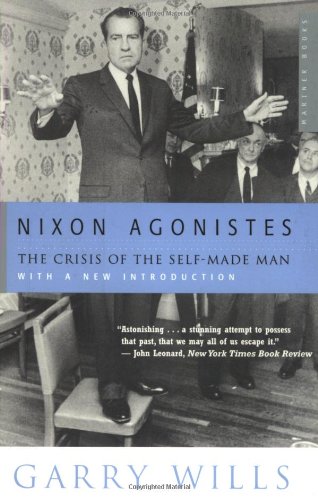
The Nixon that emerges from these pages is hardworking, and always over-prepared for everything, a man who scripted and edited his every word and gesture. If he seemed wooden and without spontaneity it is because he was his own puppet master, jerking the wires to jaw and arm. Supposing himself to lack the assets of others (the personal charm of Charles Percy, the grace of William Scranton, the wit of Adlai Stevenson, the courage of John Lindsay, the gravitas of Robert Taft, the respect accorded Dwight Eisenhower, the dignity of George Romney, the mental agility of Harold Stassen, the experience of Henry Cabot Lodge, the wealth of Nelson Rockefeller, the good looks of John Kennedy) Nixon compensated for all these these gifts bestowed on others by working longer and harder than anyone else with that famous “iron butt.” Everything he ever did in public was practiced, rehearsed, revised, practiced, rejected, redone, and so on until he reached the robotic result we all saw.
He would never give in to the human impulse to look at his watch while listening to a voter rant as George Bush (once did and was excoriated for so doing).
If Nixon throughout his career looked tired it was because he was, not having slept but instead planned, edited, and revised the next day’s every word and gesture. Nixon never trusted himself still less anyone else. This deep-rooted sense of inferiority seems to have come from nowhere; his childhood and family life before politics are numbingly ordinary.
As early as 1952 Nixon supposed that even members of his own party despised him (for his lack for such gifts as mentioned above) and this conclusion made him all the more determined never to put a foot wrong. One result of this determination was his distinctive reluctance ever to say anything in his own voice; instead he would say: “as a voter I met in Arizona said…,” or ‘as President Eisenhower said…,’ or ‘sources close to the Prime Minister said,’ and so on. It is likely that the first few times these attributions were true but in time it became a habit to distance himself from himself. Wills describes how Nixon reacted to his own successful nomination in 1968 as an example. Convincing.

Nixon leaving the White House after resigning, giving his victory gesture. ‘Victory?’ Nixon-logic.
Then there is his first inaugural, an embarrassing parroting of Kennedy’s, as if somehow to capture that magic. This Nixon reminds me of Kenneth Widmerpool when Barbara Goring poured the sugar bowl on his head (or the earlier banana incident); he was grateful to be noticed: even if as a fool. (Widmerpool is the central character in Antony Powell’s magnificient twelve volume novel, Dance to the Music of Time.)
The chapters were magazine articles on the 1968 US presidential election, and so range far and wide. Only three focus on Nixon, but that is plenty. There are also delicious accounts of Barry Goldwater, a man who loved his country so much he refused to saddle it with a lightweight president and campaigned to lose, and lose he did, and Nelson Rockefeller, a Hamlet of presidential politics whose fortune blunted his competitive ambitions and yet who later sacrificed himself rather than jeopardize President Gerald Ford’s nomination. The abiding hatred of Goldwater (acolytes) for Rockefeller is visceral. Apart from that noble sacrifice, Rocky’s finest hour was facing down the Goldwater mob in 1964. It can found on You_Tube as ‘Nelson Rockefeller denounces Republican “extremists” at the 1964 Republican National Convention.’ Those whom he denounced now run the joint.
Though it has nothing to do with Nixon, I particularly enjoyed Wills’s deflation of some of Arthur Schlesinger Jr’s many pretensions. That made me wonder how they cooperated when Schlesinger commissioned him to write the brief biography of James Madison (2002) in a series. Time may have healed that wound.
Wills, for those who do not know of him, is a master stylist, a seeker of facts, an insightful observer, a staunch Catholic, a self-described conservative, a ruthless diagnostician, an astute evaluator, an honest broker among competing ideas, a measured concluder…. He also has tangentites, a condition the spell-checker does not recognise but readers do. Sometime he can neither stop nor get to the point. That combines with some very Jesuitical logic-chopping that seems pointless, albeit spirited. At times he seems determined to find fault in anyone who takes a position, this the luxury of the journalist who never has to do anything as vulgar as come to earth.

Garry Wills
‘Agonistes’ is Greek for contestant.
In 1969 Wills refers to ‘men’ when he means ‘people.’ This will outrage anachronistic style police. I found it distracting and annoying,
Month: April 2014
Sean McGrady. Dead Letters (1992)
Krimie, recommended.
A police procedural set in the United States Postal Service at its pinnacle in 1990s before email took over. Though even at that time, the premium couriers like FedEx are cutting into its monopoly thanks to President Reagan. (I sent my first email in 1990 from Utah.) I will certainly read more in this series concerning the adventures of Eamon Wearie.
Among the strong points of the novel are the details of how post works, particularly the legal responsibility for improperly addressed items, i.e., dead letters. I doubt FedEx and UPS are bound by the same code. Then there is the ridiculous military organization at the mail depot into color-coded teams with military ranks.
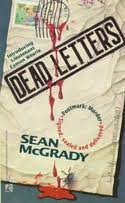
There are many personalities but the absolute standout is The Famous Barry, the medium to whom the dead speak. He surprised Eamon and he surprised me. This chapter alone makes the book worth reading. Likewise the FBI response to the medium surprised Eamon and it surprised me. Eamon’s partner Bunko is quite a guy, a good man to have at your back in a tough spot.
The contrast between the letter writer Netti, and Netti in person was another corker. It all made sense but nonetheless it took Eamon aback, and me, too. His need to find the writer of such beautiful letters was personal, but it intersected with the plot in an off-hand remark she made. Nice.
The description of small town Western Pennsylvania and inhabitants rang true, as did the descriptions of the inner harbour in Baltimore (where I went to a conference once).
On the other hand, Eamon’s capacity for feeling sorry for himself while fighting off the babes annoyed me as did the loving descriptions of Eamon’s numerous drunks.
The mystery of his boarder, Pinkus, is not resolved and seems to have been forgotten by the end.
Finally, the resolution is too quick as though the word count clicked, but I was dazed from a head cold at the time so may have missed some exposition to be sure.
The Death of a Joyce Scholar (1989) by Bartholomew Gill
Dublin Chief Inspector Peter McGarr of An Garda Síochána (Guardians of the Peace) features in a series of krimies set in contemporary Ireland. They are rich in local detail and meticulously plotted with a variety of characters from lowlifes to highlifes. At times the inner compulsion to finish a job sees McGarr venture into Northern Ireland during The Troubles.
This installment in the series rests on James Joyce’s ‘Ulysses.’ Say no more. I had to read it. A scholar from Trinity College who lectures in the thriving business of Bloom’s Day is murdered. The suspects include academic rivals, jealous lesbians, a much put upon wife, a street gang, and … well that is enough.
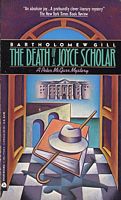
While members of his team interview and re-interview these prospects, and walk over the Bloom’s Day tour time and again retracing both Leopold Bloom’s and Stephen Dedalus’s footsteps along with the victim’s, McGarr sits in the warm June sun in the garden at home on his annual leave reading ‘Ulysses’ in search of a context for all these people and their interactions, connections, meetings, conflicts, and associations. No Dubliner can admit to not having read ‘Ulysses’ so McGarr says he is re-reading it.
It is a clever premise and it is well executed.
Harold E. Stassen: The Life and Perennial Candidacy of the Progressive Republican (2013) by Alec Kirby, David Dalin, and John Rothman
Harold Stassen (1907 – 2001) sought the Republican nomination for president 13 times between 1940 and 2000. Surely an entry there for the Guinness Book of World Records.

By the 1960s his perennial candidacy had become a national joke, but there he was all the same, joke or not, shaking hands, smiling, talking to whoever would listen. The fact is, though, he did two things no one had ever done before and which everyone has done since. He explicitly declared that he sought the 1948 nomination in 1946. There are two points here.
(1) That he overtly and explicitly said he wanted the nomination. In those days the myth was that the parties sought the nominees who waited for the call, not that the candidate sought the nomination. Stassen did. Moreover, he did it two years in advance. Again, unprecedented. No one before had ever before admitted to the ambition so far ahead of schedule, though someone like Henry Clay in the 19th Century worked four years in advance to get nominations, he never admitted it.
(2) That Stassen would contest for the nomination through the primary election. That was likewise unprecedented. Though primaries had a long existence after the waves of the Populists and Progressives at the advent the Twentieth Century they were an empty ritual at the top of the ticket. State party committees decided whom to vote for in the national nominating convention. Stassen, lacking the connections of rivals like Senator Robert Taft, the public profile of General Douglas MacArthur, and the tested staff of Thomas Dewey, based his campaign on winning primary elections. The delegates he won would not secure the nomination, went the reasoning, but the publicity of winning and the press coverage would convince state party committees that he was a winner and they would switch to him. Stassen entered every primary going and ignored the state Republic Party committees in each one of them. Not a good longterm strategy but one he persisted in. These committees then retaliated by arranging primaries so as to disadvantage upstarts like Stassen. Yet he never learned from this feedback.
Now both these steps are common practice. Aspirants start organizing and fundraising years in advance and they admit to it, if reluctantly, and they work almost exclusively through the primary election calendar.
Stassen was — wait for it — a liberal Republican. Is it any wonder that his name cannot be dredged up on the Republican National Committee’s web site. In deference to the Tea Party zealots the Republican Party continues to delete its own history, erasing Herbert Hoover, George Norris, Thomas Dewey, Arthur Vandenberg, John Lindsay, Wendell Wilkie, Earl Warren, Margaret Chase Smith, Henry Cabot Lodge, Nelson Rockefeller, Jacob Javits, Olympia Snowe, Arlen Spector, Nancy Johnson, Christine Whitman, along with Stassen.
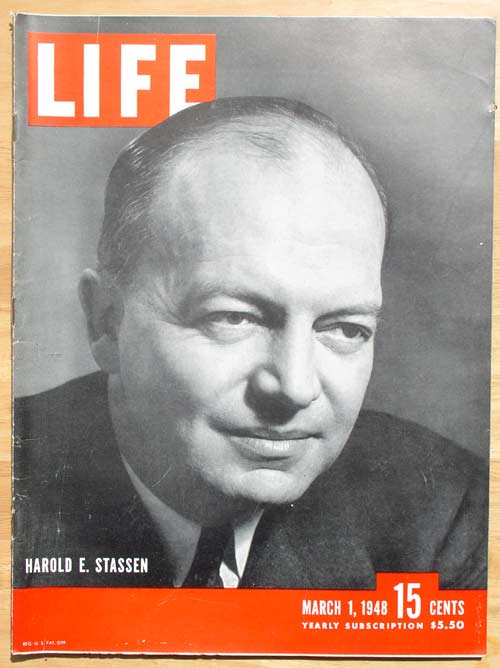
In Stassen’s time and place, being a liberal Republican meant: (1) internationalism rather than isolationism, (2) pro civil rights, and (3) cooperative with organized labor. Anti-communism was a given for all concerned. Internationalism meant working through the United Nations. Recognition of civil rights and organized labor meant not assuming that every black or trade unionists was a communist. He always referred to himself in that way, a ‘liberal Republican,’ yet the authors change that to ‘progressive Republican’ for reasons best known to themselves.
Stassen’s early career seemed charmed. He went from country attorney, an elected office, in 1938, to governor of Minnesota at 31 years of age, without seeming effort, defeating an entrenched incumbent.
When he was 33 he was the keynote speaker at the 1940 Republican national convention, and that gave him a national profile, and he caught Potomac Fever, and never recovered from it. (Other keynote speakers have later become nominees, think William Jennings Bryan or Barry O’Bama.)
He easily won re-election as governor in 1940 and 1942. That was his last elected office at 35.
In 1946 he declined to run for the Senate from Minnesota when he returned from the Navy so that he could concentrate on that presidential run in 1948. (His 1940 campaign was the creation of a few supporters at the nominating convention inspired by his keynote address. His 1944 candidacy was managed by Minnesota supporters for as a serving naval officer he was forbidden from political activity.)
President Franklin Roosevelt appointed him to the American delegation of six to the San Francisco deliberations that created the United Nations, of which Stassen remained a lifelong advocate. He worked closely with Doc Evatt at the time.
In the 1948 Republican nominating convention he finished third, behind Thomas Dewey and Robert Taft. To block the anti-labor, isolationist, anti-civil rights Taft, Stassen supported the cool and aloof Dewey who went on to lose the unloseable election to Harry Truman.
Between 1948 and 1952 Stassen served as president of the University of Pennsylvania, one of the Ivy League universities. He brought to the job a reputation as a good organizer capable of working with a variety of people and a national profile. His mission was to raise funds for the University. He took the job on the condition that he would continue his political activities. This was never a good idea, and it failed. Though it should be said that he somehow managed to protect Penn from the Red-baiting witch-hunting of the self-appointed anti-Communist crusaders who purged professors at Columbia, Harvard, and Brown.
In 1952 he supported Dwight Eisenhower against Mr. Republican, Robert Taft. But it was not clear whether Eisenhower would leave the army for politics, Stassen’s support for him also positioned him as the fallback candidate if Eisenhower declined the honour. Eisenhower did accept the nomination and won the subsequent election.
President Eisenhower appointed him to several administrative positions, which he handled well.
There follows all those other campaigns that seem like those action film stars today who keep slugging it out with Computer Generated Imagery in their 60s. He never seemed to learn from his failed campaigns and tried to do the same thing again next time, until it just became a habit. Perhaps those effortless early successes convinced him a destiny awaited, and he kept making himself available for the call. In addition to his quadrennial presidential campaigns he ran several times each for governor, Congress, mayor, and lost each time.
Stassen’s approach was low-key. At the podium he was an average speaker, but shone in question and answer sessions where he took an interest in what people had to say, no matter how many times he had heard it before or how uninformed it was, and responded in a way that communicated to the audience, farmers, factory workers, students, or voters on street corners. Likewise, he was an effective organizer and administrator who preferred to talk things over with people rather than pronounce glittering phrases that could be quoted.
Most of all, in hindsight, he is an example of that person who proclaims ‘40 years of experience,’ when the truth is that it is one year of experience repeated 39 more times. He never learned from experience.
In 1968 he was on the steps of the Lincoln Memorial when Martin Luther King gave that speech, having marched there with King (and many others). Full marks for that. Given the snide and gratuitous remarks President Ronald Reagan offered about Dr. King, it is doubtful that any Republicans these days would stand with him.
The obvious comparison is that other boy-wonder from Minnesota, Humbert Humphrey, who is scarcely mentioned in these pages. Humphrey did go into the Senate and as a result kept a higher profile than Stassen ever did after 1948.
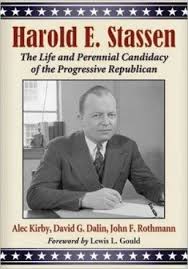
The authors keep some distance between themselves and the subject, sometimes contradicting Stassen’s own assertions. There is also much evidence of archival research. That said, I found the book hard going. It offers neither a chronological nor a thematic approach but goes back and forth between the two. It is not a biography, despite that subtitle — ‘The Life…’ — and so we never learn much about the man behind all the activities which are listed in pointless detail. The repetition suggests that the chapters were written by different co-authors. Furthermore, three-quarters of the book concerns the years 1944-1956, twelve years of his four score and thirteen.
Nor is it clear how Stassen made a living as a perennial candidate who took unpaid leave to campaign. Who paid for the buses and planes in his campaigns after 1952 is never mentioned. Did he have a core of financial backers, or just one, like Newt Gringrich, who will pay any price continually to have a message delivered, however badly? Then there is the question of his wife, whose name is mentioned now and then, and nothing more.
I met Harold Stassen in 1960 without much of idea of who he was. One of his earliest and most loyal supporters lived in Hastings and Stassen came through when campaigning in the Republican primary.

The name stuck with me, though nothing else did except that he was wearing a wig, and I have now got around to finding out more.
The French Revolutionary Calendar (190)
22 Germinal 221

Nothing reminds us of the essential irrationality of the world than, there before our eyes everyday, the calendar.
Consider the numbers: the moon’s cycle is 29.53049 days which does not yield a nice set of months. Helios is no better. The earth orbit of Sol is 365.242199 days which yields 12.36827 months. These calculations were done by ancient civilizations around the world. Some of which had enough sense to stop there. The others formed committees.
(The hole gets deeper, if we ask what ‘a day’ is. And why, oh why, the seven day week? Let’s not go there, just now.)
The Julian calendar is one compromise, amusingly portrayed in John Maddox Robert’s novel ‘The Year of Confusion’ (2010) when Caesar tired of the squabbles among the expert committee he assembled to solve this problem. As always the defining feature of an expert committee is disagreement. After exhausting the treasure and patience of Caesar, the committee produced in 46 BCE a calendar that differed from the prevailing calendar by 0.0024 of a day! The committee did have enough sense among its cantankerous members to flatter its patron with that month ‘July.’
Pope Gregory repeated the exercise in the 16th Century with the result that the months range from 28 to 31 days, and inserted every fourth year a catch-up with Leap Year. No mathematical perfection there to please the Pythagorean in our souls.
‘Pope’ did I say ‘Pope?’ Yes, the Catholic Church owned that new calendar and completely colonized it with Saints’ days, feast and fast days, and more.
When the French Revolution ushered in the Age of Reason in 1793 it was as much a revolt against the Catholic Church as the Ancien Régime. All those saints’ and fast days had to go, and they went! They were rooted out right down to the calendar itself. The year of the Revolution was Year Zero, and that was 190 years ago and April is Germinal.
Another committee was formed….. It produced violent disagreements and incomprehensible technical disputes that led some of its member to the guillotine. How else to get a consensus but with a sharp edge? So the chair of many an expert committee has asked. Iain Pears’s charming Jonathan Argyll stumbles, as always, on just such a deranged committee chair in ‘The Titian Committee’ (1999), and though committee members are murdered one-by-one, the remainder are no closer to agreement. So true. Discordant unto death which in Latin, sort of, is ‘discordat usque ad mortem.’
The French Revolutionary Calendar made the irrational world, briefly, rational with decree after decree. The day, the week, the month, and the year, all had to change. And change they did (remember that sharp edge for those who clung to the forbidden, corrupt past).
As long as the earth spins, the irrationality remains despite what a committee in Paris does. The only solution is …. Yes, more committees. In the long outfall of the French Revolution, another French committee — inspired by the success of the platinum metre — tried again in the middle of the Nineteenth Century, but it soon fell apart and one member, the irrepressible August Comte, proceeded on his own with the Positivist Calendar with months named after Moses, Homer, Aristotle, Archimedes, Descartes, Fredrick the Great, Dante, … and Bichat. Bichat? [I don’t know.] Each week also got a name, e.g., Socrates, Confucius, Mohammed… So did every single day!
The Russian revolutionaries made their own calendar with the result that their own October Revolution retrospectively moved to November! It does get confusing when time is relative. Vide Einstein.
There came another committee at the League of Nations, which produced the International Fixed Calendar, dividing the year into thirteen months, each of 28 days with an extra day at the end. Not heard of it? Few have. It died with the League to be buried alongside that other bold effort at rationality, Esperanto.
The next effort to control time was when Adolf Hitler decreed that all of Nazi subjugated Europe keep Berlin time regardless of sun or moon. Megalomaniacs all.
By the way, the French Revolutionary Calendar is essentially a blank calendar template in which nothing ever changes, as per that phrase. The more things change, the more they remain the same.

The March of Folly (1984) by Barbara Tuchman
Having read three of Tuchman’s other books with relish, I moved on to this one. This book seems to this reader to be — superbly written, true to say — a glib festival of hindsight, with some self-indulgence thrown in.
It is certainly true that governments, the focus in these pages, persist in failed polices, at times with an irrational fervor. It was said of Phillip II of Spain that ‘no experience of the failure of his policy could shake his belief in its essential excellence’ and it could be said of many others, too. (The same is also true of the corporate world, too, but that is another matter.)
That painful, self-destructive persistence takes some explanation. But it is not to be had here.

First is the indulgence: She, the doyenne of (at least) popular history, starts with the Trojan acceptance unquestioned of that wooden horse. Hey, that is the Iliad, which is fiction at best and myth at least! People do foolish things in novels and plays as plot devices. A false note at the start is not a good start.

There follow flawless accounts from the vantage of Olympian hindsight of the popes generating the Reformation, of England precipitating the American Revolution, and the United States trying to destroy itself in Vietnam. Each is certainly a remarkable example of political failure, each replete with fascinating personalities and stories which she tells far better than most; likewise much of it has been well told many times before. Another telling adds what?
The method is to identify the critics and naysayers, whom history proved right, starting with Cassandra. The naysayers show that there was doubt and that there was an alternative that was eschewed as time and effort instead went into the mistake approach, which she calls policy, a term to which we shall return below. Therein lies the rub.
There are always, I repeat, always naysayers. That they existed proves nothing. That fate in perfect hindsight vindicates some of them is no help. The naysayers are very often wrong. How can one discern the true negatives among all those negatives?
Look around, anything you see, a building or an institution, a custom or a practice had its naysayers. There is a Newton’s Law in society: for every action there is a reaction, though not aways equal, and not always opposite. One day cricket, oral vaccines, art deco buildings, trams, credit cards, women wearing pants, all of these had loud, heated, persistent naysayers, and some of them still do, by the way. The book about the March of Naysayers would fill every library shelf in the world. The file would be too big for Kindle.
So what? If everything stopped because someone feared the worst, nothing would happen.
These pages offer no way to distinguish a naysayer worth listening to from one not worth listening to. Remember that Cassandra had been against everything all her life. Like that boy who cried wolf, she had spent her credibility long ago, that is part of the joke that Homer has, the one time she was right was of paramount importance, but everyone was way past hearing her.
The very word ‘policy’ is part of the problem here. In the 1970s political parties discovered this term and began to use it to distinguish themselves. They no longer had programs, practices, procedures, or even promises, let alone principles, they had policies. Of course, no one has ever been quite sure what ‘policy’ means as distinct from all those other ‘p’ words, but it does at least mean consistency. These policies have been painted in ideological and partisan colours. Once the opposition has embraced a policy, its opponents can no longer touch that policy. Thus is the political world divided.
The media has fixed onto that consistency and first tirelessly demands that a policy be stated, and then attacks the stater for any deviation from it. It is win-win for the media. Though political parties started this game they are now reaping the whirlwind.
Pity the politician who offers no policies. Yes, I know Margaret Thatcher scorned the word but she practiced what she did not preach under the heading of principle which in her case was ‘policy’ sans le mot.
Never mind that the world is a wild beast, that circumstances change, that reality testing often returns negative results, that the same response does not always fit all cases.
The standard is consistency.
It is as though, we should demand that medical doctors prescribe the same therapy for each patient, regardless of medical history, circumstances, prognosis, capacity, etc., rather than try to tailor the therapy to the individual.
Policy, that is, consistency, is itself sometimes itself the problem. Yet the demand is always for more policy, another policy.
If all this seems inchoate and abstract, turn to the example of Franklin Roosevelt who never tied his hands with either policies or principles but willingly tried this-and-that to find something that might work. Like Abraham Lincoln, Roosevelt had a goal and he steered toward that, though not always in a straight line, which meant going left sometimes and right other times. One imagines the meal a smirking ABC journalist, or a shouting Fox …. [journalist] would make of that today.
By the way, the best book on American involvement in Vietnam remains Neil Sheehan, A Bright and Shining Lie (1989). J. Paul Vann was Thucydides in this war, and when he died, Sheehan became his amanuensis.

Empires of the Dead by David Crane (2013)
This is a study of how one Fabian Ware created the funereal symbols we now associate with World War I and subsequent wars. The subtitle is ‘How one man’s vision led to the creation of WWI’s war graves.’

A reference to ‘war graves’ brings to mind green grass and ranks of white head stones to many of us. A reference to symbols evokes the solemn statuary say in Martin Place, or the dawn ritual of Gallipoli. Each of these and more trace back to Fabian Ware’s Herculean efforts.
Before World War I and Ware’s many efforts, British war dead were left were they fell, unidentified except by their absence at the next roll call, and buried in mass pits or burned with whatever fuel was at hand. The families of wealthy officers might (try to) retrieve the body or have a memorial erected at the site. That was it. And as Britain went so went the Empire.
World War I changed that. The industrial scale of the slaughter, even in the early days of 1914 made the war dead a visible, national issue. Scale tells the story. At Waterloo Wellington’s army had 3,500 causalities. One day at Mons 1914 the British Expeditionary Force had 35,000 causalities. These men were volunteers, but later it would conscripts usually organized geographically. One result was that the eligible manhood of whole villages and towns were destroyed in a battle, say at the hellhole of Ypres, whole cities.
Ware went to France in the earliest days of the conflict as a volunteer ambulance driver. He was a good organizer and soon commanded ever more ambulances and crews. Having been a student in France he spoke the language and loved all things French, apart from the Catholicism. He saw the way the British dead were ignored, and dealt with only as a health hazard or nuisance, and he went to work with a fury.
The metal dog tag, identity disk, was one result of his efforts, along with others. Tommys originally had a cloth name tag on the inside nape of the shirt. In heaps of mangled and rotting dead bodies no one wanted to wade in and cut those out, and most would have impossible to read. Given the staggering number of dead, the British authorities preferred to list the dead as missing to reduce the impact on public opinion. This conspiracy of silence outraged Fare and an outraged Fare was cold, methodical, utterly charming to win over allies, scrupulously rational in argument, and equipped with a mind-numbing array of facts and figures all heated by an evangelical zeal.
Like Thomas Edison and other aliens, Ware needed little sleep working all day driving the ambulance and all night compiling his arguments. In time he shifted his work from ambulances to identifying the dead, and marking and recording the sites where they lay buried.
There was much resistance to this effort but he pressed on and made allies as well as enemies. It is important to note that he was doing this often amid shot and shell. He gathered around him a dedicated team whom he taught, at night after an exhausting and terrifying day’s work, to speak enough French to ask locals about ‘Morts Anglais?’
His work transformed into the Imperial War Graves Commission, and again with a perseverance, tenacity, and wit beyond mere mortal he convinced the Empire dominions of Canada, Australia, New Zealand, and India to leave it all to him.
He tried to control everything from the grass to the statuary that arose after the war. Tireless is the only word for it. Megalomania is another.

He convinced the French government early in 1915 to cede the land English soldiers were buried in to England! Imagine that. (See the note at the end for further explanation.) After the war that led to the consolidation (i.e., digging up thousands of graves and transporting the remains) into large necropolises like that vast expanse at Ypres. Every step was dogged by opposition, religious, familial, national, bureaucratic, political, institutional, church, racial, personal and Ware overcame them all. He anticipated much of this and was sensitive to religious and racial matters in handling the dead that seems enlightened by today’s standards.
In time most of this work was at a desk in London, but he would occasionally put down his pen at 6 pm in London and take the overnight boat-train to France for inspections. He descended on his field teams and more than once took a shovel himself. The men who worked for him hated these inspections for he was a strict taskmaster, but admired his commitment to the cause.
Like Steve Jobs he sweated the small stuff as well as the large.
What was that ‘cause’ any way? World War I, he thought, as did many others, was the last war and even more important it was an Empire war that united all the British peoples, all those naive volunteers, all those conscripts, all those lads from the Dominions, together they were everyman. Most had no wealthy families to care for them in death, and, as a Christian, death and those mortal remains had a sanctity that had to be respected. Moreover, the enormity of the death would discourage future wars, if only that enormity were brought home, he thought.
Death is a democrat; it takes all just as we are. Ware was an egalitarian at this level. He prevented many wealthy families from retrieving their beloved dead in contradiction to his vision of a single nation from all walks of life and parts of the world united in death. Imagine the outrage that caused. Only 10% of the one million British and Empire dead were identified, i.e., 100,000 but the families of many of those wanted their — son, brother, husband, nephew — to be singled out as an exception and some were willing to campaign for it and to pay for it. Thousands of letters to the Times denounced Ware in every way. Aristocrats petitioned the Palace and lambasted successive prime ministers. There questions in the House! Ware tried to explain his reasoning in response but the abstractions of equality or the vague promise that mass, majestic, silent cemeteries would stay the sword next time meant nothing to the bereaved here and now. The budget cutters in parliament snipped away as did Treasury. A perfect storm! How did he come through it all?
There is more to the story that is best read. And remember the Imperial War Graves stretched from Mesopotamia to East Africa to Gallipoli to Palestine to Greece to Italy and to the Western Front.
It is another of those cases that shows what a single person with intelligence and will — a Gulliver among the Lilliputians — can accomplish pretty much singlehanded, at the start, even in the face of vast bureaucracies (the Army, the Public Works Office, Treasury) that have other important priorities and in the face of an orchestrated and angry public reaction.
The story is much more powerful than the telling. The book is hard going. Many sentences I had to read twice to get the point. Obscure, elliptic, cryptic, inverted, recessive, these words come to mind in describing the prose.
Note. Ceding the land for cemeteries meant it cost nothing, but much more important it made the very land, say, at Étaples forever British even more permanent than an embassy.

In 1940 when the German army occupied Étaples it thus occupied British territory as much as the Channel Islands. The British flag flies there by right, not by courtesy. That is a gesture as thoughtlessly magnanimous as Winston Churchill’s in 1940 offering to surrender British sovereignty to France by combining the countries as one to continue the war. Another story there.
Ron Hansen, Isn’t it Romantic? (2003)
Recommended for fun
Take two late twenty-something French cosmopolitans, she Helen of Troy beautiful, he devastatingly handsome, on the outs and plonk them down in Seldom (Pop. 398), Nebraska and see what happens. That is the hypothesis of this short novel.
If Seldomites are surprised to see, first, Natalie walking down the dusty road with a roller bag, and then half-a-day later the wild-eyed Pierre burst out of a bus that had no business being there, they did not show it. Owen continued curating his shrine to BIG RED FOOTBALL, Carlo continued to think of nothing and no one but Iona who has ignored him (with some difficulty in this very small town) for years, Mrs. Christensen continued to experiment with jello and kool-aid, but Dick Tupper did notice Natalie, did he ever, and Iona did notice Pierre!
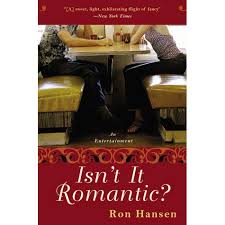
Natalie understands most English said to her full-face, using dictionary words, in proper constructions, and slowly without idioms. Not a common occurrence in Seldom. As a result, ….
Pierre gets about one word in twenty, which is enough when Owen… Well, read the book to find out.
Seldom, it turns out, has a few surprises of its own to offer. (I now know how CarHenge came about. If you don’t know CarHenge, maybe you should inform yourself by visiting: http://carhenge.com)
The setting is in the Sandhills where nature remains hard at work.
The result is charming, unexpected, delightful, and finally what you always knew would happen but not quite like that. Think of those screwball film comedies — It Happened One Night, Bringing Up Baby, My Favorite Wife, You Can’t Take It With You — from the 1930s and that is the right planet.
